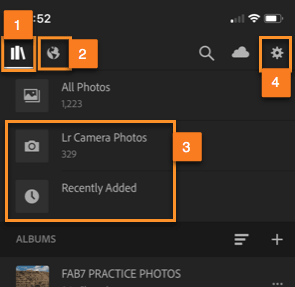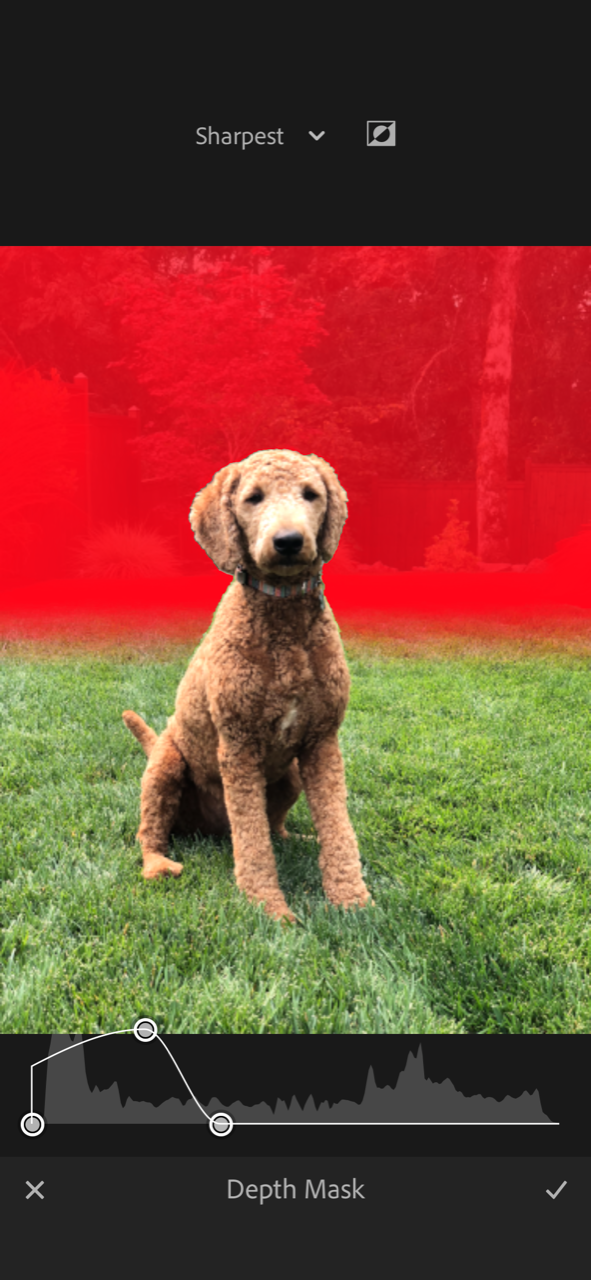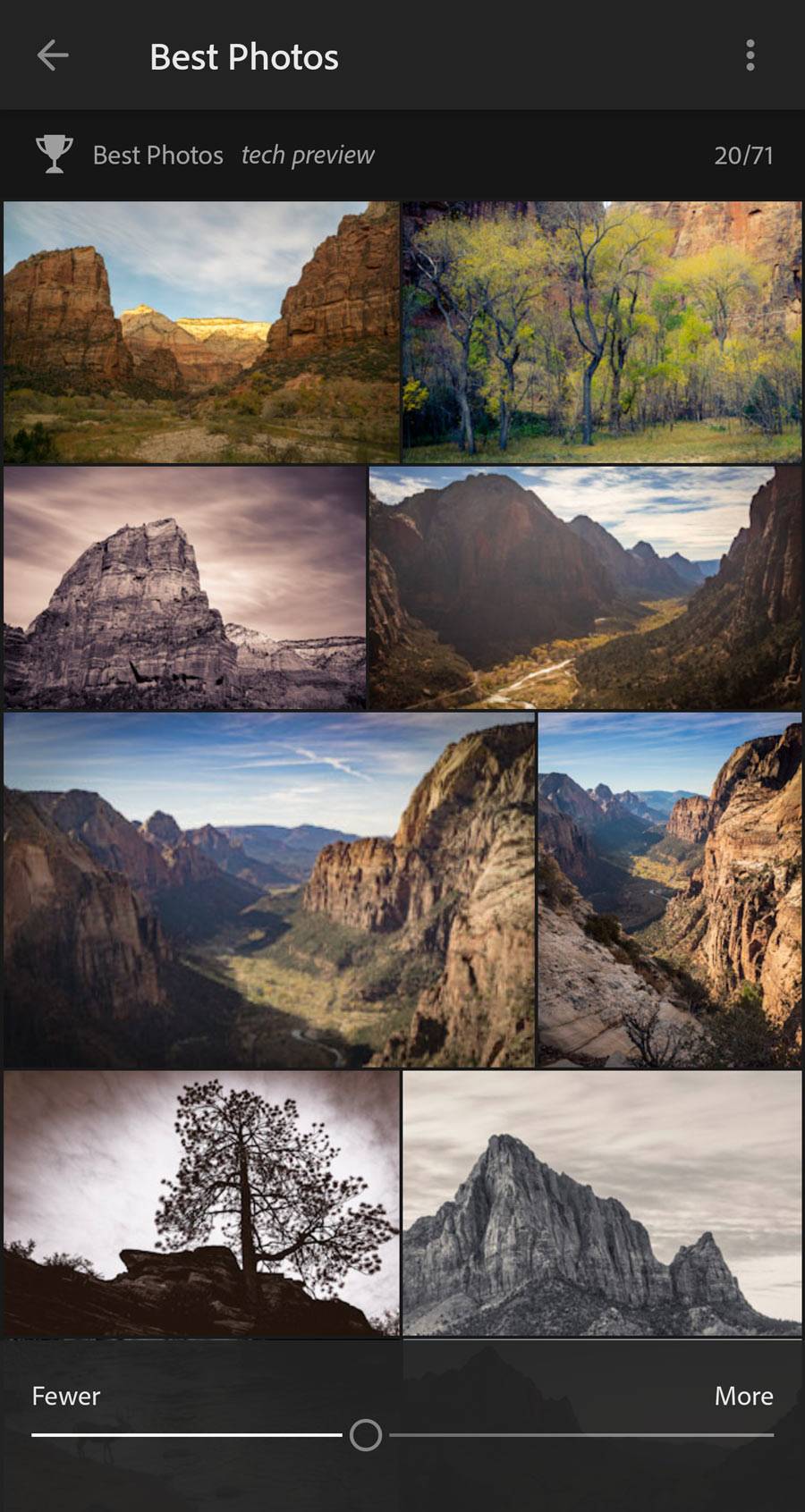 Adobe today released update 1.5 for the Lightroom CC cloud-based desktop application. Updates for iOS and Android have also been announced – but they won’t ship for up to a few weeks.
Adobe today released update 1.5 for the Lightroom CC cloud-based desktop application. Updates for iOS and Android have also been announced – but they won’t ship for up to a few weeks.
An update to Lightroom Classic was also released – see my Lightroom Classic article for details on this.
To update Lightroom CC Desktop, go to Help>Updates, and on the Apps tab click on Update next to Lightroom CC (not Lightroom Classic or Lightroom CC 2015!).
In This Article:
Faceted Searches
Now in Lightroom CC Desktop and Lightroom CC iOS (not yet in Android), easily search for images from a particular camera, lens, or other facets (characteristics). In the Search bar, type in the facet name followed by a colon (:), and a list will popup with values present in your search location. For example, type camera: to select from a list of cameras you have shot with.

Below are the facets currently available. These aren’t listed in the application at this point, so make a note of them or bookmark this page.
Facets:
- keyword
- camera
- lens
- location
- rating
- flag
- flash
- orientation
- iso
- type (image, video)
- extension (.jpg, nef, etc.)
- f-stop (aperture)
- ss (shutter speed)
- edited
There’s currently no way to select two or more values from the list at the same time (such as two cameras or a range of ISOs). To select more than one value of camera, for example, type camera: and select the first camera; then type camera: again and select the second. This creates an OR condition – images shot with either the first camera or the second one.
If you use a second facet in your search (or a non-facet search term), this will create an AND condition between facets (or between the first facet and the additional search term).
Example: camera: iPhone 6, camera: iPhone X, rating: 5-stars will be interpreted as:
(camera=iPhone 6 OR camera=iPhone X) AND rating=5 stars
To delete a facet from your search, hover over the facet and then click on the X on the facet. To clear the search entirely, click on the X to the right of the Search box.
![]()
New Cameras Now Supported
Raw files from the following new cameras can now be imported into Lightroom CC Desktop, iOS and Android and into Lightroom Classic:
- Parrot Anafi
- Sony DSC-RX100M5A
- Sony DSC-RX100M6
Click here to see a list of all cameras supported in each version of Lightroom (and Camera Raw).
New Lens Profiles
Other Lightroom CC Desktop Enhancements
See What Albums an Image Is In
With an image selected, the Info panel will now show what album(s) the image is in, if any. Click on an album name to jump to that album with the image still selected. To access the Info panel, click on the “i” icon in the bottom right.

Choose Default for Edit Settings to Copy
If you copy edit settings from one image to others, you know that in the last update we got the ability to choose which edit settings to copy, by clicking on …, choosing Choose Edit Settings to Copy, and then choosing those settings you want to copy.
Now, if you regularly copy a common set of settings, set this set as the new default so that you can then just copy and paste rather than having to go into Choose Edit Settings to Copy. To set a new default, click on …, then Choose Edit Settings to Copy. In the dialog, check the settings you want to be part of the default, then click on the three dots and choose Set Default. To return to Adobe’s set of default settings, choose Reset Default.

Store Album Locally
If you’re not storing copies of your photos locally (i.e. on your hard drive; this is set in Preferences>Local Storage), but you expect to be disconnected from the internet and want to be able to work on and share your photos, select one or more albums of photos and store them locally. Right-click on an album and choose Store Album Locally. To stop storing locally, right-click and select Store Album Locally again to uncheck it.
Coming to iOS (iPad and iPhone)
In addition to faceted search, new camera support and new lens profiles, the following will be coming within a few weeks to iPads and iPhones:
Albums Reorganization
- On iPads, navigate through folders and albums/collections while having a photo grid visible.
- On iPads and iPhones, Albums view (#1 in the screenshot) now has an easy way to get to and control shared albums/collections – tap on the globe icon (#2).
- New Lr Camera Photos and Recently Added “smart folders” (#3).
- Lr settings have been moved to within the gear icon in the top right (#4).

Depth Map Technology Preview
This feature, available on iPhones with dual cameras (7+, 8+, X), enables you to capture HEIC images with depth maps. When editing these images, you’ll find a new Depth Map selection tool within the brush, and linear and radial gradients, that allows you to make a mask (i.e. a selection) based on distance from the camera. Then you can add to the mask with the brush or subtract with the eraser.

Watch my video tutorial below for complete details on this depth map feature or read on below the video.
For best quality, after hitting Play click on the sprocket wheel in the bottom right and choose 720/HD.
To enable the depth map technology preview, in Albums view tap on the gear icon, choose Technology Previews, and enable Depth Map Support.
In the Lightroom camera, choose Depth Capture:

To use the depth map to build a mask for local edits, after capturing an image and opening it in Edit view, choose Selective (bottom left), tap on the + to add an adjustment, choose Depth Map as the type (the last of the four icons), then drag on the curve or in the image to change what portion of the image is affected – this will be shown in red. Tap on the checkmark to complete, then modify the mask as desired with the eraser and/or brush. Finally, make the edits that you wish to (such as darkening with negative Exposure).
Other iOS Changes
- New multi-select mode: when in grid view in an album, long tap (press and hold) on a thumbnail to select it and to enter Select mode. Then slide your finger lightly along other thumbnails you want to add to the selection. To remove from the selection, tap or slide on already-selected thumbnails.
- There no longer is a limit of 15 images in Export/Share.
- There are now filters based on media type, camera, location, keywords, edited.
- HDR and long-exposure photos will have smaller file sizes – up to 2/3 smaller than before – with no loss in quality.
Coming to Android Devices
In addition to new camera support and new lens profiles, the following will be coming within a few weeks to Lightroom CC on Android devices:
- On the Optics tab, remove chromatic aberration and apply lens profiles:

- Apple HEIC file support
- Pause and resume cloud syncing, within the Cloud Status tab.
- Best Photos technology preview: identifies best photos based on edits you’ve made and Adobe Sensei artificial intelligence technology. Turn on in Settings>Technology Previews.

- New guided tutorial: Adding a Watermark
Related Content


Wow, Laura. There was a lot of stuff to absorb and, as always, you explain it clearly. Thanks!